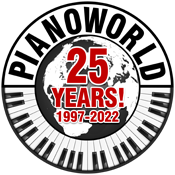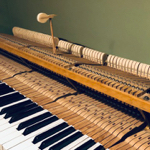 |
Welcome to the Piano World Piano Forums
Over 3 million posts about pianos, digital pianos, and all types of keyboard instruments.
Over 100,000 members from around the world.
Join the World's Largest Community of Piano Lovers
(it's free)
It's Fun to Play the Piano ... Please Pass It On!
|
|
|
|
37 members (8ude, accordeur, danno858, David Boyce, David B, 8 invisible),
1,491
guests, and
92
robots. |
|
Key:
Admin,
Global Mod,
Mod
|
|
|
|
Joined: May 2008
Posts: 11
Junior Member
|
OP

Junior Member
Joined: May 2008
Posts: 11 |
The Yamaha CLP 230 has a Damper with half pedal effect whereas the CLP 220 has the damper but without the half pedal effect.
What's the difference and is it really important?
|
|
|
|
|
Joined: Aug 2004
Posts: 194
Full Member
|

Full Member
Joined: Aug 2004
Posts: 194 |
Half pedal allows you to have different levels of sustain depending on how far you press the pedal. A damper without half pedal effect is essentially an on/off switch.
Once you get used to using it, it's a nice feature and I'm glad I have it. However, I could live without it.
|
|
|
|
|
Joined: Jun 2004
Posts: 8,483
8000 Post Club Member
|

8000 Post Club Member
Joined: Jun 2004
Posts: 8,483 |
it's important if you're a serious player, because half-pedal is the simulation of any acoustic piano's damper effect. half-pedal simply means the pedal has continuous damper effect according to your foot pressure. without it, the pedal is just an on/off switch with one single preset sustain level.
right now, all new Yamaha models, even entry ones, have half-pedal functionality, which simply makes those older models without half-pedal outdated.
|
|
|
|
|
Joined: Apr 2005
Posts: 4,534
4000 Post Club Member
|

4000 Post Club Member
Joined: Apr 2005
Posts: 4,534 |
"Half-pedaling" is a non-issue, in my opinion.
I had many yrs. of classical lessons as
a child, and I've been playing for more
than 30 yrs., and I never heard the term
"half-pedaling" until I joined these forums
in 2005. I played only acoustic pianos
as a child and I never "half-pedaled"--
whatever that is--on them, as far as I am aware.
(The nearest I can figure is that "half-
pedaling" is simply a term to justify
sloppy pedaling.) Since 1989 I've been
playing only digitals. My first digital,
bought in 1989, didn't have "half-pedaling,"
and I never noticed that I was missing
anything. My next digital, bought in 2005,
didn't have it either, and I didn't notice
anything missing. My current digital,
bought in 2006, has it, and I don't see
any difference between it and the
other two digitals that didn't have
it--whatever it is. This is a total
non-issue, in my view.
|
|
|
|
|
Joined: Nov 2007
Posts: 658
500 Post Club Member
|

500 Post Club Member
Joined: Nov 2007
Posts: 658 |
The issue of partial pedaling is one of long-stating repute. The damper pedal on an acoustic piano lifts the dampers off the strings so that they will resonate longer. Because the pedal is an analog device, it's possible to govern how far the dampers are lifted by controlling how far down one presses the pedal. This, in turn, affects the duration of the resonance of the strings.
By leaving the dampers just slightly touching the strings you can shorten the resonance making the sound a little crisper while still getting a longer sustain. In general the use of partial pedaling is a matter of training your ear.
Some people like to have lots of resonance and a long sustain while others like very little. In part it's a personal preference. However, for some pieces it becomes a more substantial issue. If a piece is to be played legato but there's no way you can hold the keys down and make a stretch a little partial pedaling can help, especially if full pedaling would blur the notes.
Ed
"...a man ... should engage himself with the causes of the harmonious combination of sounds, and with the composition of music." Anatolius of Alexandria ![[Linked Image]](https://www.pianoworld.com/ABF_Medals/12xmedals.jpg) YouTube Channel YouTube Channel
|
|
|
|
|
Joined: Aug 2004
Posts: 194
Full Member
|

Full Member
Joined: Aug 2004
Posts: 194 |
LOL, half-pedaling = sloppy pedaling. Good one.
Half-pedaling is a very legitimate technique, and a fine feature to have on a DP. Those that use it (us sloppy folks) tend to use it frequently. My teacher, who has fantastic pedaling technique, half-pedals all the time and encourages me to as well.
|
|
|
|
|
Joined: Dec 2006
Posts: 252
Full Member
|

Full Member
Joined: Dec 2006
Posts: 252 |
for a serious player having half-pedal capability on a DP is mandatory. You can't play Debussy and Ravel properly without it and the technique is used often in other music as well to get specific tonal effects. If you're still not convinced you might take a look at "the Pianists Guide to Pedaling" by Joseph Banowetz. it will be an eye opener in what is possible using advanced pedal technique. While you can't replicate everything on a DP, you should have a DP allow you to do as much as possible
Steinway B - 1958
Shigeru SK7
|
|
|
|
|
Joined: Jun 2004
Posts: 8,483
8000 Post Club Member
|

8000 Post Club Member
Joined: Jun 2004
Posts: 8,483 |
when someone is saying 'half-pedal' is non-issue, the first question comes to mind is whose opinion is that, an amateur/not-that advanced player, or a professional/advanced pianist. since no pro or advanced pianists would ever dismiss half-pedal as a non-issue, we can pretty much draw our own conclusion and ignore such a comment.
|
|
|
|
|
Joined: Apr 2007
Posts: 391
Full Member
|

Full Member
Joined: Apr 2007
Posts: 391 |
Originally posted by Gyro:
(The nearest I can figure is that "half-
pedaling" is simply a term to justify
sloppy pedaling.) WHAT?! Quite the contrary! You've just lost my respect. Half-pedaling is a precise technique that enables a little bit of sustain without blurring all the notes together as with a full pedal. Sometimes you need full pedal. Many times it sounds much better with varying degrees, which we call "half." I couldn't live with an on/off pedal. The on/off full-or-not pedaling is what is sloppy, and it comes out in the music!
Charles Walter Queen Anne 1520 (polished cherry)
Roland fp-4 (black)
|
|
|
|
|
Joined: Nov 2007
Posts: 154
Full Member
|

Full Member
Joined: Nov 2007
Posts: 154 |
I think we've had this half-pedaling argument with Gyro before, IMHO his opinion is just as wrong now as it was before, but he is certainly entitled to his opinion. Anyone care to guess what my classically trained concert pianist wife who is also a piano instructor has to say about half-damper, etc.? Short answer is, yes, it is most important. I guess my wife and I will just remain in the "sloppy pedaling" group!!
Clyde
DX7IIFD, SY77, SY99, Hammond C3, Steinway L, CP300, etc.
|
|
|
|
|
Joined: Apr 2008
Posts: 314
Full Member
|

Full Member
Joined: Apr 2008
Posts: 314 |
-------------------------------------------------------------------------------- Quote: I played only acoustic pianos as a child and I never "half-pedaled"-- whatever that is--on them, as far as I am aware.-------------------------------------------------------------------------------- Well, that really says it all doesn't it? 
Dennis C.
Piano Store Operator,
Former District Manager,
20 Year Industry Experience
"Tell the truth, honor God, and make money!"
|
|
|
|
|
Joined: Jul 2012
Posts: 10,594
10K Post Club Member
|

10K Post Club Member
Joined: Jul 2012
Posts: 10,594 |
It may be that half pedalling is only effective on expensive instruments, along with a lot of other things which may label a guy`s talent almost as according to his wallet . . .some stuff`ll never sound good on a run of the mill upright; it would only be a technical exercise at best.
"Nobody's heard of Queenadreena"
|
|
|
|
|
Joined: Jul 2012
Posts: 593
500 Post Club Member
|

500 Post Club Member
Joined: Jul 2012
Posts: 593 |
half-pedal simply means the pedal has continuous damper effect according to your foot pressure. On my DP, I'm pretty sure the half-pedal is not a continuous adjustment. It's strictly 0%/50%/100% (or whatever the middle number would be). Otherwise I think the feature would be boldly labeled "continuously variable".
|
|
|
|
|
Joined: Apr 2007
Posts: 3,552
3000 Post Club Member
|

3000 Post Club Member
Joined: Apr 2007
Posts: 3,552 |
We've observed in testing with MIDI instruments that basically all DP's that feature half pedal send a number of different MIDI levels for partial pedaling: 0, 15, 30, 45, etc, for example. The hardware is definitely capable of (more or less) continuous adjustment.
However, you may be correct in thinking that the onboard tone generator (and perhaps even software pianos) are not capable of usefully using these tones beyond 0/64/128. In fact, there was some discussion a while ago about annoyance that Ivory and Galaxy had half pedal kicking in at a different MIDI velocity. That makes me think they, and probably many other instruments, are just as you describe, despite the MIDI values and hardware supporting more.
|
|
|
|
|
Joined: Oct 2018
Posts: 614
500 Post Club Member
|

500 Post Club Member
Joined: Oct 2018
Posts: 614 |
BUMP!
Up to date views, s'il vous plait. Including--is there a half-pedal capable pedal available for, say...Roland FP30?
I see the M-Audio SP-2 advertised as having "acoustic type sustain"... not sure what that means--is that one half pedal capable, or not? (Looks as if I might get one anyway--looks more useful and less liable to escape one's foot, than this...flat, oblong thing that came with the DP...)
....I blame the honourable member from Sofia for this new thickfingers idea...I'd never heard of " half-pedalling" until very recently. If it could be of use to a Jingle Bells novice like me, I'd sooner start out with it than have to adapt later. I must admit, I do find the "on-off" of the FP30 bundled pedal a bit sudden, sometimes....
|
|
|
|
|
Joined: Apr 2007
Posts: 7,268
7000 Post Club Member
|

7000 Post Club Member
Joined: Apr 2007
Posts: 7,268 |
I guess you refer to me  Half-pedaling is IMO important mostly for classical music, especially romantic repertoire which (in my very oversimplified view) includes a lot of (semi-arpeggiated) chords that blend into each other, sometimes over the same bass or even over an arpeggiated bass, etc. including trills and other stuff like that. Half-pedaling allows for you to kind of "clean-up" a bit the mess from the current chord into the next one without however cutting it off fully which would be too abrupt. I can't explain that in a better way since that all is now so internalized into me I rather do it subconsciously  But half-pedaling is of utmost importance at least to me.
Last edited by CyberGene; 01/21/19 10:13 AM.
|
|
|
|
|
Joined: Apr 2018
Posts: 9,824
9000 Post Club Member
|

9000 Post Club Member
Joined: Apr 2018
Posts: 9,824 |
is there a half-pedal capable pedal available for, say...Roland FP30? Both the Roland KDP-70 (which I have) and the DP-10 support half pedaling. Both work with the FP30.
![[Linked Image]](https://forum.pianoworld.com//gallery/42/medium/12282.png) across the stone, deathless piano performances "Discipline is more reliable than motivation." -by a contributor on Reddit r/piano "Success is 10% inspiration, and 90% perspiration." -by some other wise person "Pianoteq manages to keep it all together yet simultaneously also go in all directions; like a quantum particle entangled with an unknown and spooky parallel universe simply waiting to be discovered." -by Pete14
|
|
|
|
|
Joined: Nov 2016
Posts: 4,329
4000 Post Club Member
|

4000 Post Club Member
Joined: Nov 2016
Posts: 4,329 |
For FP-30 you would need either the Roland DP-10 (or the old DP-8?) single pedal or the KPD-70 triple pedal bar.
And of course your imagination is the only limit for usage scenarios. Maybe staccato doesn't quite work? Playing legato is difficult or impossible? Full pedal would be too muddy? Use half pedal.
Or you can press it down gradually while repeating some chord or pattern for an artistic effect.
It might also be useful to not learn a bad habit of always stomping the pedal fully down and releasing it all the way and lifting your foot off from it as that might sound pretty bad (mechanically) on a real piano.
|
|
|
|
|
Joined: Oct 2018
Posts: 614
500 Post Club Member
|

500 Post Club Member
Joined: Oct 2018
Posts: 614 |
Thanks very much, fellas. Razbira se, CG!
Sooo...looks like I may need a DP10, then (don't need or want the triple pedal). Can't determine whether this would provide half-pedalling on the FP30, though...I've seen reference to "half-pedal capable keyboards", but no reference to the FP30 being thus capable. Does a "capable" pedal provide H-P on any piano, then?
The nearest I've seen to evidence is the DP-10 "capable" pedal being sold (bundled) with the FP30, but that's all.
Short version Sloth--when you say "both work" with the FP30, does that mean both provide the feature for the FP30? Thanks.
|
|
|
|
|
Joined: Apr 2018
Posts: 9,824
9000 Post Club Member
|

9000 Post Club Member
Joined: Apr 2018
Posts: 9,824 |
when you say "both work" with the FP30, does that mean both provide the feature for the FP30? yes
![[Linked Image]](https://forum.pianoworld.com//gallery/42/medium/12282.png) across the stone, deathless piano performances "Discipline is more reliable than motivation." -by a contributor on Reddit r/piano "Success is 10% inspiration, and 90% perspiration." -by some other wise person "Pianoteq manages to keep it all together yet simultaneously also go in all directions; like a quantum particle entangled with an unknown and spooky parallel universe simply waiting to be discovered." -by Pete14
|
|
|
|
Forums43
Topics228,457
Posts3,405,495
Members114,972
| |
Most Online15,252
Mar 21st, 2010
|
|
|
|
|
|
|


![[Linked Image]](https://www.pianoworld.com/ABF_Medals/12xmedals.jpg)




![[Linked Image]](https://forum.pianoworld.com//gallery/42/medium/12282.png)